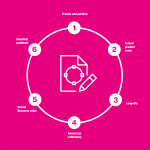Total Quality Management (TQM) is a structured system for satisfying internal and external customers and suppliers by integrating the business environment, continuous improvement, and breakthroughs with development, improvement, and maintenance cycles while changing organizational culture. TQM aims for quality principles to be applied broadly throughout an organization or set of business processes. Total Quality Management (TQM) programs focus on improvement in individual operations with unrelated processes; as a consequence, it takes many years before all operations within a given process are improved. Six Sigma focuses on making improvements in all operations within a process that produce results more rapidly and effectively.
The Six Sigma’s Breakthrough Strategy is a disciplined method of using extremely rigorous data-gathering and statistical analysis to pinpoint sources of errors and ways of eliminating them. Six Sigma relies on the voice of the consumer to set the standard of acceptable performance. Six Sigma has a systematic approach to both validate data and to focus on the critical few inputs that will have the greatest potential to effect meaningful improvement.
Six Sigma focuses on reducing defects in management and clinical process; it uses statistical analysis to find the most defective part of the process, and rigorous control procedures to sustain improvement.
While Six Sigma is a long-term strategy, it is designed to generate immediate improvements to profit margins too. Compared to traditional quality management programs such as TQM that project three or more years into the future, Six Sigma focuses on achieving financial targets in twelve-month increments.
TQM and Six Sigma have a number of similarities including the following:
1. A customer orientation and focus
2. A process view of work
3. A continuous improvement mindset
4. A goal of improving all aspects and functions of the organizations
5. Data based decision-making
6. Benefits depend highly on effective implementation
A key difference between TQM and Six Sigma is that Six Sigma focuses on prioritizing and solving specific problems which are selected based on the strategic priorities of the company and the problems which are causing the most defects whereas TQM employs a more broad based application of quality measures to all of the company’s business processes. Another difference is that TQM tends to apply quality initiatives within specific departments whereas Six Sigma is cross-functional meaning that in penetrates every department, which is involved in a particular business process that is subject to a Six Sigma project.
Another difference TQM provides less methodology in terms of the deployment process whereas Six Sigma’s DMAIC framework provides a stronger platform for deployment and execution. For example, Six Sigma has a much stronger focus on measurement and statistics, which helps the company, define and achieve specific objectives. Six Sigma is complementary to TQM because it can help to prioritize issues within a broader TQM program and provides the DMAIC framework, which can be used to meet TQM objectives.
Conclusion
Both measurements of quality control within an organization have brought true success to companies who have applied their policies and procedures.
The leaders and management teams of any organization will have to evaluate which quality of control tactic is the most beneficial to the growth and improvements of their business.
The one way to analyze your business is to establish your goals and vision for your organization and set plans in place to evaluate if Six Sigma or Total Quality Management falls in the realms of what you are seeking.
Both processes have taken the best of the best countries and companies from good to great and I personally feel that as long as you have one of these processes in place, you are setting yourself up for success.
.

96,063 Comments
https://roommx.com/
I’m not sure why but this site is loading very slow for me.
Is anyone else having this issue or is it a issue on my
end? I’ll check back later on and see if the problem still exists.
Do you have a spam issue on this site; I also am a blogger, and I was wanting to know
your situation; we have created some nice procedures and we are looking to swap techniques with others, why not shoot me an e-mail if
interested.
buy metformin 1000 mg online
Quality articles or reviews is the crucial
to attract the people to pay a visit the web site, that’s what this web site is providing.
Thanks for ones marvelous posting! I definitely enjoyed
reading it, you happen to be a great author.I will be sure to bookmark your blog and will come back in the foreseeable future.
I want to encourage you to ultimately continue your great work, have a nice day!
Good response in return of this difficulty with genuine arguments and telling the whole thing about that.
WOW just what I was searching for. Came here by searching for travel
Excellent beat ! I would like to apprentice
while you amend your website, how can i subscribe
for a blog website? The account aided me a acceptable deal.
I were tiny bit acquainted of this your broadcast
provided brilliant clear idea
I really love your site.. Pleasant colors & theme.
Did you make this web site yourself? Please reply back as I’m trying to create my own personal blog and would like to know where you got this from or just what the theme is called.
Cheers!
You really make it appear really easy with
your presentation however I in finding this topic to be really something which I think I’d by no means understand.
It sort of feels too complicated and very wide for me.
I’m having a look forward for your next post, I’ll try to get the hang of it!
This article will help the internet visitors for creating new website or even a weblog from start
to end.